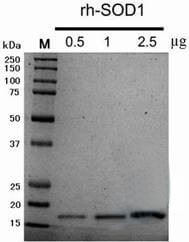| |

| |
首页 > 蛋白类产品 > 重组人源铜锌超氧化物歧化酶(rhCu, Zn-SOD)
重组人源铜锌超氧化物歧化酶(Recombinant Human Copper, Zinc-Superoxide Dismutase, rhCu, Zn-SOD)
| Superoxide Dismutase1 (SOD1) |
| LT12010 |
| 10mg |
| Freeze-dried powder |
|
17 kDa |
|
ATKAVCVLKG |
|
Escherichia coli |
|
≥ 95% |
|
< 1.0 EU/µg protein |
|
Cadmium < 0.5 ppm; Mercury < 0.5 ppm; Lead < 6.5 ppm (1 ppm=1 µg metal/g protein) |
|
≥ 10,000 IU/mg protein (Determined by Marklund assay at 35°C)
≥ 10,380 IU/mg protein (Determined by SGS according to GB/T5009.171-2003 I) |
|
-20°C in the dark |
| 3 years |
|
Superoxide dismutase (SOD) is a metalloenzyme. It is present in all living organisms, including animals, plants, and microorganisms. SOD is categorized based on its metallicity into copper, zinc-SOD (Cu, Zn-SOD), manganese-SOD (Mn-SOD), and iron-SOD (Fe-SOD). The physiological significance of SOD is that it can convert toxic superoxide free radicals into hydrogen peroxide. It is living organisms’ primary means of scavenging oxygen free radicals. Almost 60 diseases have been shown to be directly related to oxygen free radicals and the level of SOD has used as an indicator of aging and death. SOD can prevent superoxide-free-radical-induced damage at the cellular level and locally repair damaged cells. It plays an important role in anti-oxidation in living organisms. SOD is also a key component in cosmetic products and has been approved by the Ministry of Health of the People’s Republic of China because it can delay aging, regulate immune response, and blood lipid levels, and prevent damage from solar radiation. |
|

|
| It is recommended that the product be reconstituted with sterile water into a final concentration of 10 mg/ml . Avoid multiple freeze-thaw cycles and exposure to frequent changes in temperature.
The use of strong acids and bases, strong oxidants, and high concentrations of organic solvents should be avoided to prevent denaturation. |
| For research use only! |
|



